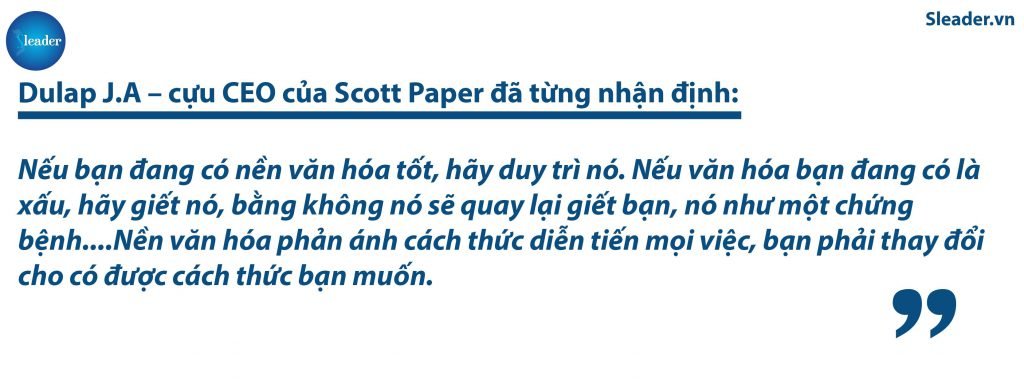
Change your culture for successful strategy execution
Why do many businesses develop great strategies but fail? There are many reasons to explain the above problem, including cultural dependence. In fact, connecting the organization\’s culture with the way its strategy is executed is something that most executives often forget.
Strategy and culture: strong interoperability
Each company inherently has a unique culture. This culture is made up of the beliefs and ideas of all members about doing the job. That is why each company conducts work in its own style. In addition, the cultural nature is automatic reflex perception and action. For example, the salesperson said “hello” every time a customer entered the store. Corporate culture is shown and felt through that greeting. If employees have a corporate culture, they will express a responsible greeting, customers will hear the “hello” sent by the employee. On the contrary, if there is no interest, that greeting will turn into a lifeless sentence.

The strategic-cultural relationship is extremely tight. The administrators have concluded that, if the strategy is to be compared to the county, then culture will be considered Earth. If the “earth” is not good, no matter how hard you try, the seed cannot sprout and grow. Specifically, beliefs, goals and habits applied in a strategy may or may not be compatible with corporate culture.
A culture-appropriate strategy will motivate people to do the job, increasing the strength of the organization and efficiency in the strategy\’s execution. A typical example in the strong relationship between culture to execute a successful strategy is Toyota North America. Not only has the right and different business strategy led to the great victories of the Japanese in the American car market, but the corporate culture has encouraged employees to work better, to design the precision mold and the car door are not sagged. It is thanks to the cultural environment that Toyota is able to use the most sophisticated management tools, such as a feedback box, and in just 2 years, the number of employee comments has increased from less than 10,000 to over 1,000. 000, resulting in $ 250 million in savings.
If the organization knows how to cohesion and use culture as a tool to support the implementation of the strategy, it will create an effective competitive tool and differentiated value of the organization. Starbucks is a prime example of using corporate culture to effectively communicate strategy globally. With the strategic goal of making Starbucks the “third home” for the fun of the home and the workplace, they have built Starbucks locations into a fun, comfortable and easy place for chatting and chatting. Not only that, but the manners and services that staff treat guests at the cafe also create sympathy for everyone.
Moreover, the ingenuity in the way it operates has helped this business to stay strong even in times of global financial crisis, when companies are massively cutting staff. In addition, Starbucks creates a business by connecting humanity, employees here are considered “partners”, even part-time employees also enjoy very full employee policies (stock options coupons, medical insurance). They boldly invest in staff training including short and long-term courses. Former president of the company, Howard Behar, believes that when businesses care about employees, the employee will care about its customers just like that.

Therefore, leaders need to be aware of the importance of connecting culture and strategy, as Starbucks realized and implemented it from the very beginning. In reality, corporate culture in many organizations mainly creates stability, not forming a soul as a true living entity. That makes the perceptions, behaviors and understanding of the values of the members of the organization fragmented, leading to inconsistent and inconsistent actions. This is one of the reasons that makes implementing the strategy more difficult. Because culture is invisible, inaccessible and cannot be quantified, few organizations have invested time and money to build from the beginning or just do it collectively, not clearly. Besides, not all businesses have a strategic plan right from the start. As a result, many organizations often struggle to find a way to form this strategic-cultural cohesion.
In addition, the new strategy but the old culture will hinder the implementation of the strategy if these two cannot be reconciled. The more solid the culture, the more difficult it is to adopt a new strategy. Because people in the organization do not know what to do to integrate the strategy into the corporate culture. Because of that incompatibility, organizations often have difficulty in successfully adopting a strategy.
Where should cultural change start?

Changing a company\’s culture and incorporating a strategy is one of the most difficult tasks for managers. When organizations want to improve their culture, they often assume to focus on the negative aspects and try to fix them. But that doesn\’t work. The first step executives should take is to identify positive points in corporate culture that have similarities that can support strategy. After finding these points, administrators seek to display and expand communication throughout the organization. The plan must be presented with clear and vivid actions to change the culture – actions that everyone understands are aimed at building a new culture in accordance with the strategy.
Administrators need to encourage good behavior and practices towards strategy execution. For example, the employee commendation ceremonies for outstanding performance, teambuilding programs for members, organizing training to improve employees\’ qualifications … These are symbolic activities and needs to be done professionally to drive culture towards strategic relevance. In addition, leaders need to understand their role in accelerating cultural change toward strategy.
For example, at Microsoft, from the very beginning, Bill Gates and Paul Alen made their own working style the “standard” of Microsoft. They want to make their employees as comfortable, productive and happy as possible while working. Not only that, Bill Gates is a person who encourages the creativity of employees, listens, appreciates their opinions for the company, considers and develops the company. Or for example, the leaders at Wal-Mart are always at the forefront of savings, not allowing waste, and tight control of costs. Taking the lead as an example of corporate leaders in Eastern countries, including Vietnam, is a measure with relatively great persuasion, because: “Eastern peoples are inherently rich in love and love. to them, a good example is more effective than a hundred good speeches ”.

In addition to being an example of activities for cultural communication, leaders need to persuade members to turn them into action, persistent and persistent. More than that, creating and maintaining a culture of strategic incentive is the job of the entire management team. Cultural changes require initiative from many people. Senior leaders, department heads, and middle managers must repeat the values, “meet and exchange”, and transform the organizational philosophy into daily routine.
In short, the goal of building culture within the organization is to help employees move towards better, happier and more productive things. Each member of the organization is different wheels of the same vehicle. Despite their differences, they must be united in action and coordinated action to bring the wagon towards the same direction as the intended destination. Therefore, culture is the rope that connects members together to perform for a common strategic goal. Altering the cultural aspects to the strategy being pursued needs to be done continuously, persistently over a long period of time, so leaders need to be patient, smart and more, no. never compromise, compromise.
Source: Institute of Strategic Leadership (SLEADER)



